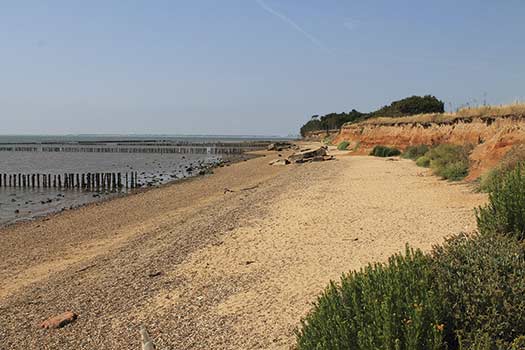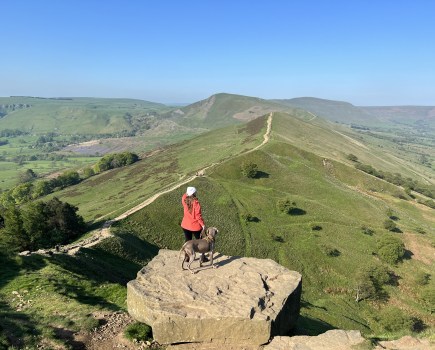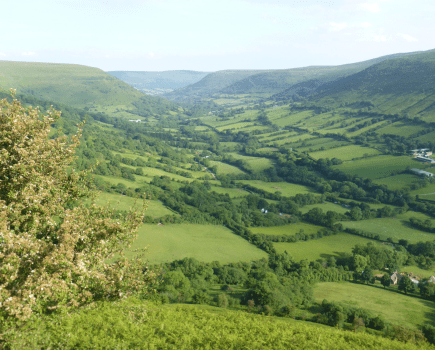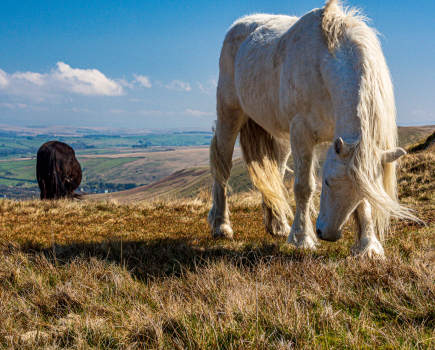Edoardo Albert explores the ancient history on a remarkable island
A wild walk can be an excursion into time as well as place. I’ve always been fascinated by how the geography of Britain has changed over the centuries, with generations of farmers nibbling at the sea, while the sea gnaws the coast elsewhere. Mersea, a tidal island in the Colne Estuary, demonstrates this vividly. And who wouldn’t want to walk around an island?
To avoid the July heat I crossed The Strood, the causeway linking Mersea to the mainland, at dawn. Now tarmac, and regularly inundated at high spring tides, The Strood is itself a link to the past, for the causeway was first laid around 700 AD, when an Anglo-Saxon magnate ordered up to 5,000 oak pilings to be sunk into the underlying clay. Oak pilings don’t talk, and later Viking invaders destroyed pretty well all written records in East Anglia and Essex, but one candidate as builder was the monk-king, Sæbbi of Essex, who abdicated to devote himself to prayer.
The rising sun drew a morning mist from the ground and sea. The tide was coming in and in the dawn silence I heard its slow swirl through the channels of the mud flats. Continuing across the island to West Mersea, I parked and set off clockwise around the island. Walking away from the harbour, seaweed-shaggy pilings rulered out into the slowly filling channel and, when I again reached the causeway, the lunarscape of mud flats had been replaced by flat sheets of grey water.
From here, a short detour inland made for a long walk into the past. At the top of the rise overlooking the causeway is a barrow dating from the start of the second century AD. Now, topped with an oak tree, it would once have been the most visible feature of the landscape for people crossing the causeway. When the mound was excavated early in the 20th century, archaeologists found, at the heart of the barrow, a lead box containing cremated bones, creating a conundrum under the hill. For the Romans did not raise barrows, and the Britons did not cremate their dead. But here were both.
Returning to island circumnavigation, I followed the Pyefleet Channel. The sun had burned off the morning mist and the water sparkled in the early light. Saxon invaders, in their shallow-draughted boats, used these channels as highways into the country’s heart. Not far up the coast, at Sutton Hoo, an Anglo-Saxon king was buried in one of these boats, accompanied into the next life by some of the most magnificent jewellery and armour ever made. It was not hard to imagine the creak of rowlocks and the hiss of oars as the dragon-prowed boats moved stealthily upstream. Indeed, the settlers and invaders of 1,500 years ago were accompanied by much the same soundtrack as I was: the harsh croak of seagulls, the piping whistles of curlews, and the hiss of water and wind. For a few miles I walked in a soundscape unaltered for thousands of years.
The north shore of Mersea Island is quiet. I saw a handful of people, mostly on boats, but many swifts, the birds of eternal summer, jinking over the salt marshes, and, along a thistle-lined stretch of path, a cortege of butterflies accompanied me on my way.
Reaching the tip of the island, the North Sea opened out, unusually blue and tranquil, to the south, the land marked by shallow orange cliffs. The sea is hard at work gnawing the land here. Tree roots jut out into empty space, clawing against the inevitable, and then, finally, tumble down upon the beach. The cliffs were laid down 300,000 years ago when elephants, rhinos and bear roamed the area, and fossil hunters still turn up remains.
The sun was up and I was thirsty and hungry. An advantage of this walk was ending it at one of the excellent seafood shacks in West Mersea, eating the wildlife – oysters, cockles, shellfish – that had, unseen, underwater, accompanied me around the island.
ROUTE DESCRIPTION
- Follow coast path clockwise from West Mersea.
- At The Strood, head inland on road to barrow, then return to coastal path back to Mersea.

Edoardo Albert explores the ancient history on a remarkable island
A wild walk can be an excursion into time as well as place. I’ve always been fascinated by how the geography of Britain has changed over the centuries, with generations of farmers nibbling at the sea, while the sea gnaws the coast elsewhere. Mersea, a tidal island in the Colne Estuary, demonstrates this vividly. And who wouldn’t want to walk around an island?
To avoid the July heat I crossed The Strood, the causeway linking Mersea to the mainland, at dawn. Now tarmac, and regularly inundated at high spring tides, The Strood is itself a link to the past, for the causeway was first laid around 700 AD, when an Anglo-Saxon magnate ordered up to 5,000 oak pilings to be sunk into the underlying clay. Oak pilings don’t talk, and later Viking invaders destroyed pretty well all written records in East Anglia and Essex, but one candidate as builder was the monk-king, Sæbbi of Essex, who abdicated to devote himself to prayer.
The rising sun drew a morning mist from the ground and sea. The tide was coming in and in the dawn silence I heard its slow swirl through the channels of the mud flats. Continuing across the island to West Mersea, I parked and set off clockwise around the island. Walking away from the harbour, seaweed-shaggy pilings rulered out into the slowly filling channel and, when I again reached the causeway, the lunarscape of mud flats had been replaced by flat sheets of grey water.
From here, a short detour inland made for a long walk into the past. At the top of the rise overlooking the causeway is a barrow dating from the start of the second century AD. Now, topped with an oak tree, it would once have been the most visible feature of the landscape for people crossing the causeway. When the mound was excavated early in the 20th century, archaeologists found, at the heart of the barrow, a lead box containing cremated bones, creating a conundrum under the hill. For the Romans did not raise barrows, and the Britons did not cremate their dead. But here were both.
Returning to island circumnavigation, I followed the Pyefleet Channel. The sun had burned off the morning mist and the water sparkled in the early light. Saxon invaders, in their shallow-draughted boats, used these channels as highways into the country’s heart. Not far up the coast, at Sutton Hoo, an Anglo-Saxon king was buried in one of these boats, accompanied into the next life by some of the most magnificent jewellery and armour ever made. It was not hard to imagine the creak of rowlocks and the hiss of oars as the dragon-prowed boats moved stealthily upstream. Indeed, the settlers and invaders of 1,500 years ago were accompanied by much the same soundtrack as I was: the harsh croak of seagulls, the piping whistles of curlews, and the hiss of water and wind. For a few miles I walked in a soundscape unaltered for thousands of years.
The north shore of Mersea Island is quiet. I saw a handful of people, mostly on boats, but many swifts, the birds of eternal summer, jinking over the salt marshes, and, along a thistle-lined stretch of path, a cortege of butterflies accompanied me on my way.
Reaching the tip of the island, the North Sea opened out, unusually blue and tranquil, to the south, the land marked by shallow orange cliffs. The sea is hard at work gnawing the land here. Tree roots jut out into empty space, clawing against the inevitable, and then, finally, tumble down upon the beach. The cliffs were laid down 300,000 years ago when elephants, rhinos and bear roamed the area, and fossil hunters still turn up remains.
The sun was up and I was thirsty and hungry. An advantage of this walk was ending it at one of the excellent seafood shacks in West Mersea, eating the wildlife – oysters, cockles, shellfish – that had, unseen, underwater, accompanied me around the island.
ROUTE DESCRIPTION
- Follow coast path clockwise from West Mersea.
- At The Strood, head inland on road to barrow, then return to coastal path back to Mersea.








